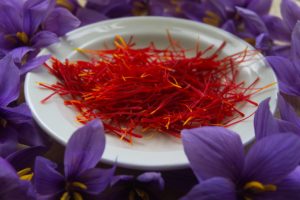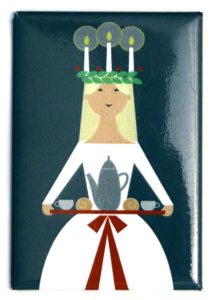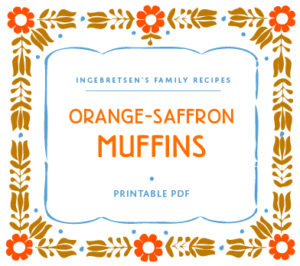
Photo credit: Autumn Carolyn
Oranges and saffron. Their flavors and color warm winter’s crisp aesthetic. Saffron gives a warm glow to Swedish baked goods and is best known for its use in Lucia buns. Citrus is at its peak during our coldest months – a pleasant gift of vitamin C when we need it most. Anne Gillespie-Lewis brought these two ingredients together in a simple muffin recipe with a sophisticated flavor.

Anne says, “I like saffron. A lot. I first encountered it with Lucia buns, then I went on to learn other ways to use it. The muffins were inspired by saffron cakes, which are popular in Nordic countries. This is a quick alternative.” These muffins are more than that, however. I think Autumn, who tests the recipes with gluten-free alternatives, has it right when she says, “They’re the best muffins I’ve ever had!”
Less is more
Ensure that you have the same result as Autumn did and remember the cardinal rule of muffin-making: Only beat the batter long enough to moisten the dry ingredients. Ignore the lumps.
Those of us who like to see ribbons of batter flow off a spoon after mixing thoroughly must practice restraint when making a muffin. Silky batters mean that the gluten in the flour has been activated. The muffin will be tough, with tunnels throughout. Learn to leave well enough alone.
A light hand works is important when using saffron, too. “You don’t want to dump it in!” laughs Anne. This remarkable spice gives the golden color and the aroma to the muffins. While people are often reluctant to buy saffron because of the per ounce price, most stores sell smaller amounts. A tiny bit is all you ever need in a single recipe.

Saffron journeys north
The price makes sense when you learn that every step in the cultivation and production of saffron is done by hand. The spice is the stigma of crocus sativa. One hundred and fifty to two hundred stigmas are needed for an ounce. The crocus grows best where it is hot and dry. Iran produces 90% of the saffron available and Spain produces much of the remaining 10%. In both countries, saffron production is primarily a family business. Sadly, adulterated saffron has impacted the marker. Ground saffron is the easiest to dilute. Therefore it’s best to buy the whole stigmas to ensure you have the real thing. It stays fresher when it is kept whole, too.
Saffron came into Danish and Swedish cuisine when each country established an East India Trading Company, in 1616 and 1731 respectively. The Nordic love for all things bright during the midwinter ensured saffron being quickly adopted in Lucia celebration food. It’s a distinct and complex flavor, complementing simple flavors such as buns, cakes, muffins, and rice. Saffron does not keep its flavor for a long time. So once you open a container to make the muffins, don’t set the remainer aside for a special occasion. Make a few more batches of muffins, bake some Lucia buns and shape them into Valentine’s hearts, or sprinkle whole threads over rice for an elegant touch. It is a luxury that is meant to be used.
Saffron brightens moods

Another reason Northern Europeans may have had an appreciation of saffron is its anti-depressant qualities, which is particularly useful in midwinter. Medieval nuns in Germany were given an allotment of saffron to lift their spirits. It also helped them through the rigors of Lent, especially the all-night vigils. A researcher at Murdoch University in Perth, Australia found that saffron encouraged the growth of new neurons in the brain, a finding that is joy-inducing in itself. So, please make these muffins. You will be happier and smarter.
How to use saffron
There are three schools of thought on how to incorporate saffron into baking ingredients. One is that you grind it and add it to the dry ingredients. The best way to grind the saffron is in a mortar and pestle. Or, you can fold a sheet of kitchen parchment in half, place the saffron in the fold and gently rub the sides together. If you are having difficulty, take a teaspoon of sugar from the recipe’s total amount of sugar and add it to the saffron for a little extra friction.
Grinding, sugar, and liquids
The second school is that you grind it with sugar and put the powder into a couple of tablespoons of liquid. You then add the mixture to the wet ingredients. Since saffron is used regularly in Iranian cuisine, I asked an Iranian friend and superb cook what she though was best. In a combination of shocked English and Farsi, she let me know that there is only one way – take your saffron, ground with sugar, and mix it in two tablespoons of whatever liquid you are using in the recipe.
Once the sugar is dissolved and the saffron colors the liquids, then, and only then, can it be added to the other wet ingredients. To bolster her viewpoint, she arranged a Facebook Live meeting with an esteemed Iranian cookbook author, who told me in no uncertain Farsi that grind + liquid is the only way to treat saffron. I don’t speak Farsi, but I have a very good listening comprehension of Chef Aghast, so I considered myself told.
Then there is the easy way…
The final way is Anne’s favorite. Find ground saffron from a reputable buyer, add it to the dry ingredients, and skip all of the other steps. The choice is yours, Dear Reader. Anne and I will not pass judgement.
(When testing the recipe, Autumn and I used saffron threads from our Lake Street neighbor, Bill’s Imported Foods,721 West Lake Street. If you aren’t local, you can order high quality saffron here.)
The recipe
Orange-Saffron Muffins
1 cup sugar
3 eggs
1 cup melted butter or vegan butter, cooled
1/4 teaspoon of powdered saffron
Zest of one orange
1/3 cup of orange juice (about one medium orange, juiced)
2/3 cup milk or almond milk
2 and ¼ cup flour or almond flour
1 and ½ teaspoon baking powder
½ cup golden raisins, optional
Cupcake liners
Pre-heat the oven to 400 degrees.
Beat the sugar and eggs together until light.
Add the melted butter, zest, orange juice, saffron, and milk, beating after each addition.
Combine the egg mixture to the flour and baking powder. Beat lightly, just until all the ingredients are blended, but the batter is still lumpy. Add golden raisins, if using.
Fill cupcake liners half-full and bake 15-20 minutes or until they are golden brown and test done.

One thought on “January Sunshine: Orange Saffron Muffins”